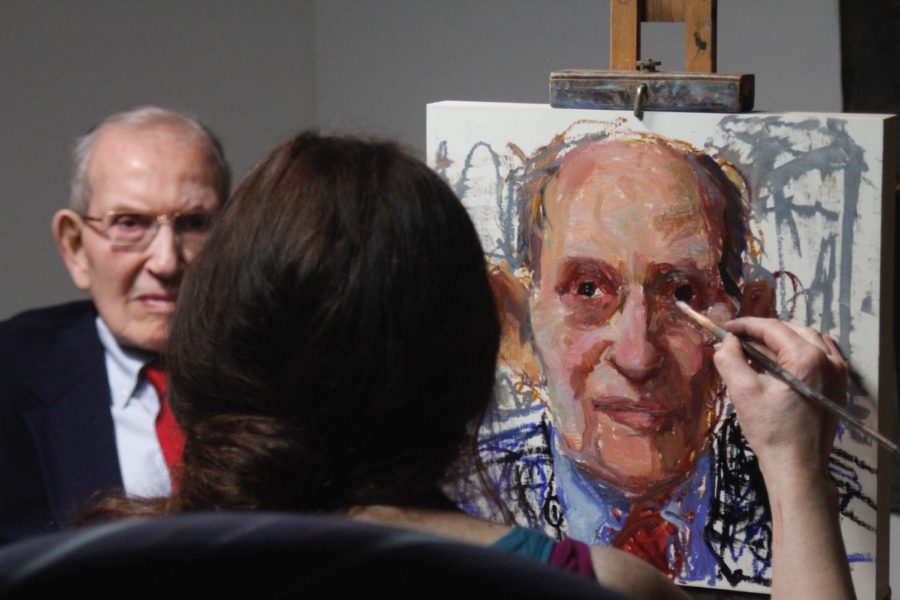Life on Canvas: Artist depicts the faces of Iowa State
Artist Rose Frantzen likes to speak to her subjects about their past lives. Warren Kuhn shared a lot about his time in the war, and his time in New York.
March 29, 2017
As Rose Frantzen traced the lower eyelid of the face on the canvas, she told Warren Kuhn the story of how her brother joined the army.
“He was a grunt. That’s the lowest level that you can be at when you join,” Frantzen said as she picked up another shade of skin tone from her palette to add to Kuhn’s portrait.
“He was a grunt? So was I,” Kuhn said.
As Frantzen dabbed a lighter-colored paint to highlight Kuhn’s forehead, he told her about an explosion he witnessed while he was in Korea as a war correspondent. Frantzen listened and asked questions, but her brush never stopped moving across the canvas.
Frantzen will be painting former Iowa State faculty and staff from March 29 to April 6 as part of the upcoming “Faces of Iowa State” exhibition. The public is invited to watch her paint live in the lower level of the Christian Petersen Art Museum.
Frantzen painted 19 portraits of Iowa State faculty and staff during the 2016 Iowa State Fair. The idea to continue the portrait series developed last September.
“The idea really snowballed with input from community and support from the deans,” said Erin O’Malley, campus outreach coordinator for University Museums.
Once the 13 new portraits are completed, they will be added to the Iowa State Fair collection and exhibited at the Brunnier Art Museum in the fall. In January 2018, the exhibit will embark on a two-year tour around the state of Iowa.
“The idea is to get everywhere in the state what we can, since the portrait sitters are from all over,” O’Malley said.
Each of the portrait sitters were selected by their respective colleges or university departments. Most are retired faculty or staff, and were selected because of their contributions to the university. On Wednesday, Frantzen painted Warren Kuhn, a former dean of library science from 1967 to 1989.
Frantzen completed a similar project in her hometown of Maquoketa, Iowa. Between July 2005 and July 2006, Franzen painted 180 portraits of anyone who wanted to come into her studio and pose for her. Participants ranged from infants to retired community members, and the exhibit was displayed for nine months in the National Portrait Gallery at the Smithsonian in Washington, D.C.
Frantzen will meet each sitter for the first time on the day of the portrait sitting. The portraits begin with a basic outline, but they evolve as Frantzen works more with the subject and gets to know their personalities.
“I love your 93-year-old ears. They’re just so much fun to paint,” Frantzen said as Kuhn smiled for her once more.
Frantzen used a wide variety of colors to create the faces of her subjects, and O’Malley noted that her choices may seem unconventional at first.
“She brings a lot of personality to the painting. She’ll pull out purple and green, and you’ll wonder, ‘How will this become skin tone, or hair?’ But she always works it out,” O’Malley said.
Frantzen moved to clean off her palette and take a break at the halfway point of the portrait. But she couldn’t quite pull herself away, and kept coming back to adjust small details of the portrait.
“I had a mentor who told me, ‘You never take a break unless you can die and the painting still looks good,’” Frantzen said.







